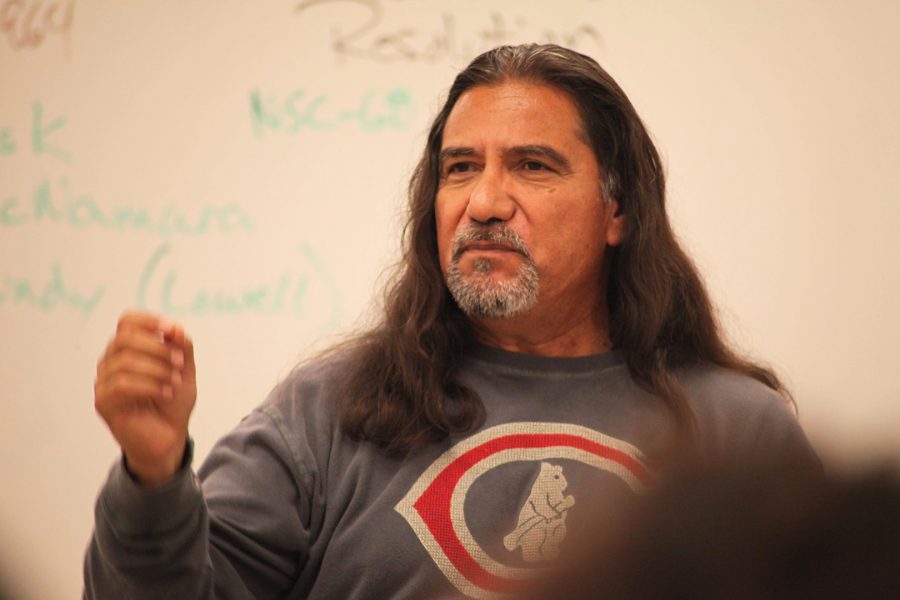Dr. Raul Chavez, 59, is a history professor at Mt. SAC who teaches US, Mexican American, and Native American history classes. He is of Mexican and Native American descent, and says that he’s not concerned with people on the internet saying that he hates white people, but he instead focuses on getting his students to “think brown.”
Chavez was raised in Baldwin Park, California in the late 1960s and early 1970s, when the demographics were predominately working-class white families with traditional values. They hadn’t yet begun to see the new wave of Mexican immigrants, which meant speaking Spanish outside of his home was uncommon. He has kept in touch with friends from high school, and it wasn’t until decades after high school where he learned that some of his friends spoke Spanish too.
“I didn’t know I was Mexican, if that makes sense. You just live your lives,” Chavez said.
He grew up with traditional Mexican culture but didn’t really think much about being Mexican. He was more conscious of being Native American, because his family denied it despite both Chavez’s mother and father having Native American backgrounds. He grew up watching his grandmother cook meals, make home remedies and perform rituals of the Tarahumara Natives of the Sierras of Chihuahua, Mexico. Although his grandmother engaged in indigenous behavior, she hated being called india (Indian woman) and denied that part of her, so his family hid it. It wasn’t until later in his life when he decided to search for answers and an understanding about that part of him.
After graduating from Baldwin Park High School in 1977, Chavez went out to New Mexico State University to play baseball. He found himself 10 minutes away from the city of Juarez, Mexico where he had relatives. He strayed away from college and gravitated towards experiencing his Mexican culture in Juarez, where he ended up living for five years. His experience living in Juarez is where he had an epiphany and came to the realization that he was Mexican. He became in tune with his Mexican culture in Juarez, where he lived in a neighborhood called El Piojo, and he learned to speak chuco (Mexican slang). He spoke Spanish 75 percent of the time, watched telenovelas (Spanish soap operas), listened to Spanish music; he was immersed in Mexican society and loved it.
He came back to Los Angeles in 1982 and attended Mt. SAC as he focused on his education again. He jokingly said that, that’s when he learned that he was actually smart.
He said that it wasn’t about being smart, it was about his dedication, commitment and focusing his energy on performing his duties. It started with a promise that he made to himself, to never be absent to a class. That promise kept him from losing focus on his immediate goal, which was to pass every class. Eventually that goal would lead him to his next goal which was getting his bachelor’s degree in economics. He started coaching sports back at his alma mater, Baldwin Park High School and worked as a substitute teacher to supplement his coaching hobby.
This is what started his journey as a professor.
He quickly became aware of the different outcomes of students with gang related backgrounds. They seemed less focused on their education, although they were just as smart as the other students, but they lacked the motivation. This inspired Chavez to want change in the curriculum in the schools to give students a sense of identity. It motivated him to start his master’s program in 1991 focusing in Chicano studies. This gave him the opportunity to work with influential professors and mentors such as American historian Rodolfo Acuña, Ph.D., which helped guide him in the right direction. Shortly after, he got a job at Mt. SAC as a professor and enjoyed teaching at the college level.
For six years he worked as part-time professor at several different colleges throughout Southern California. He continued his educational journey and achieved two master’s degrees; one in Chicano studies and one in US history. Throughout the 1980s and 1990s, Chavez had links with the Mescalero Apache Reservation in New Mexico.
It was then and there that he was finally able to relate to and make the connections to his Native American upbringing. It influenced him to decide on selecting a direction that would feed his soul and spirit, which was to achieve his doctorate in Native American history. His achievements made him more marketable to obtain his position as a full-time professor at Mt. SAC, where he is currently completing his 19th year.
There are reviews where some students have written that Chavez hates white people. Chavez responded by saying that he can see how some people misconstrue what he says to mean that he hates white people, because often people shut down as soon as they hear him condemn white privilege. They get defensive and stop listening to what he is actually saying.
“I don’t hate white people, I hate people who promote and protect white privilege,” Chavez said.
That’s why he has started to introduce a counter ideology that he calls “thinking brown.” In it you recognize and respect the experiences of brown people in history and our current society. Chavez stated that people don’t have to be brown to “think brown,” just as there are brown people that promote white privilege, there are also white people that “think brown” and respect the brown experience.
Chavez stated that what’s wrong with America is that we’re afraid of what the word racism means, which prevents us from recognizing and dealing with the residual effect that racism has caused.
“Our founding fathers were racist; they believed in white privilege and created a system that promoted and protected white privilege; and for almost 200 years that’s what our society was,” Chavez said. “We can’t deny that they created this great nation and industrial might that is the United States, but we also can’t deny that they did it at the expense of women and people of color.”
He tries to get his students to understand that racism is prevalent in our society today and that until we start addressing racism, we won’t be able to fix the problems.
Chavez said that he often reflects and reevaluates himself. He states that his long hair physically represents his indigenous side, but the waviness of his hair represents the European side of him. Through his Native American side, he sees a world of beauty and balance, which he tries to teach to his students. The way he delivers and presents this message to his classes, with passion and rants, is where he sees his European side come forward. Chavez said we should enjoy the fruits of this country’s multiculturalism, as he personally enjoys the cultural differences within his own family. His family burns sage to cleanse their home, they share in prayers, they make tamales, and they celebrate Christmas among many other indigenous, Mexican, and American traditions.
Chavez currently teaches US, Mexican American, and Native American history classes. In all of his classes he will continue to teach his students to “think brown”.



